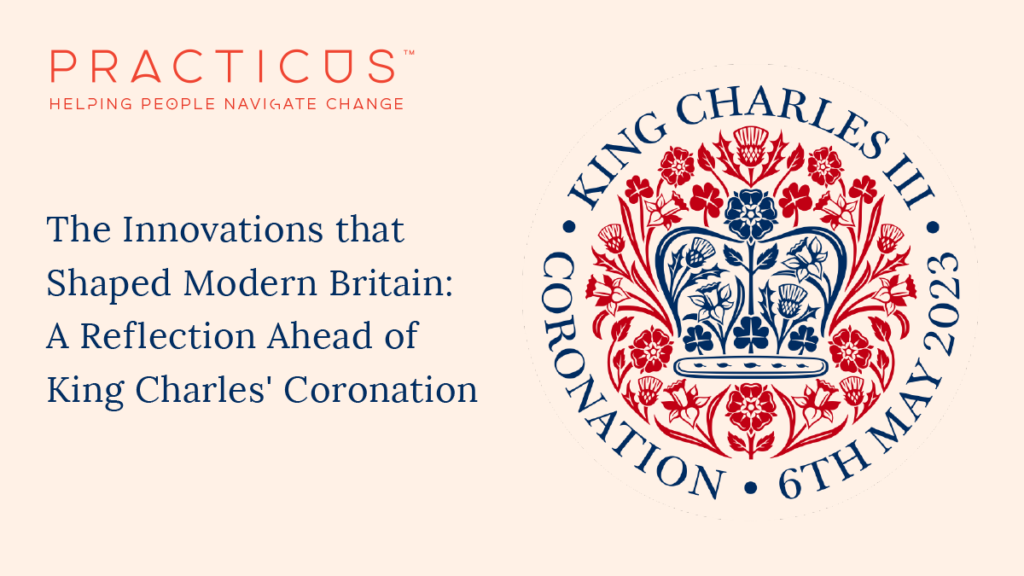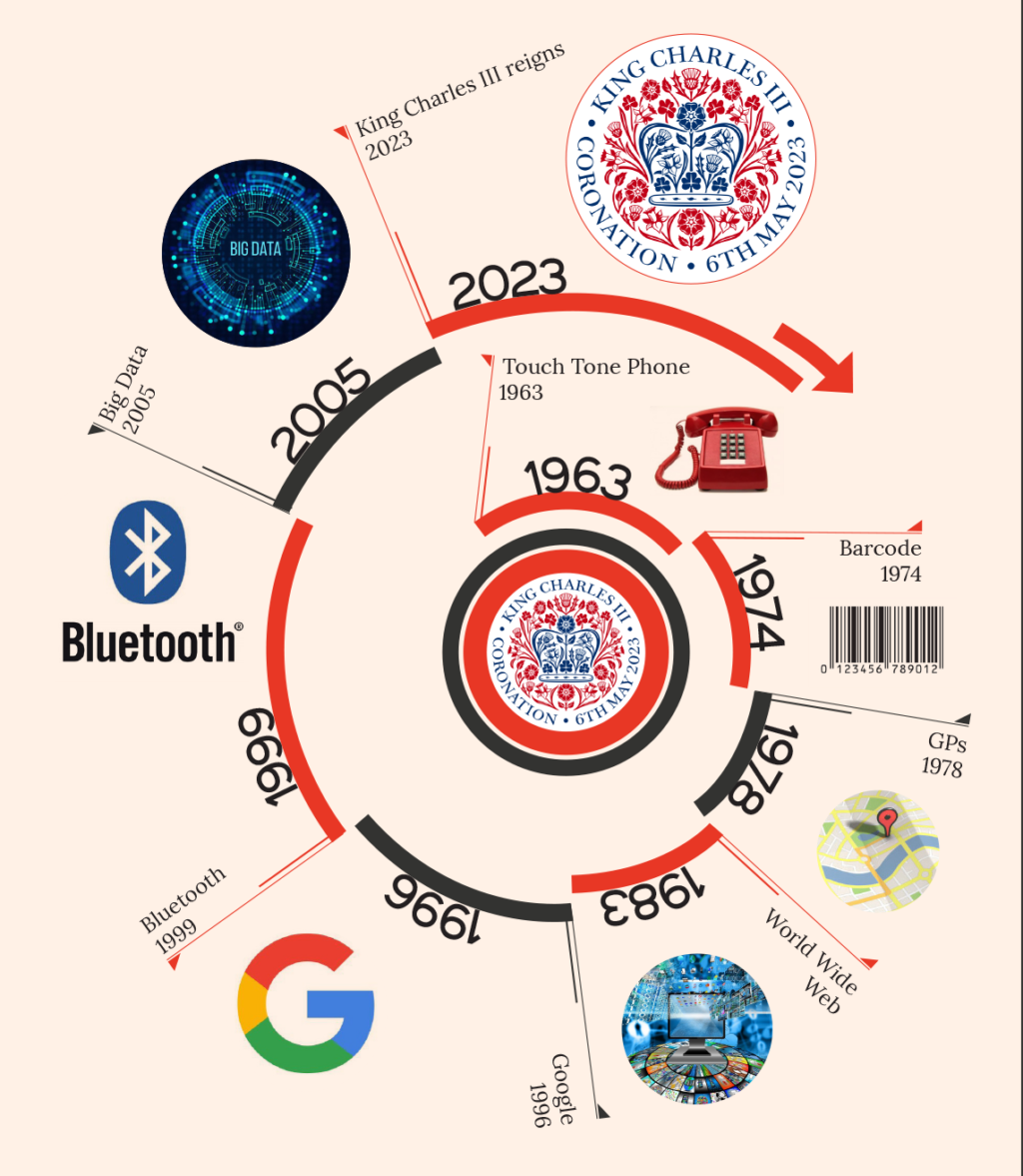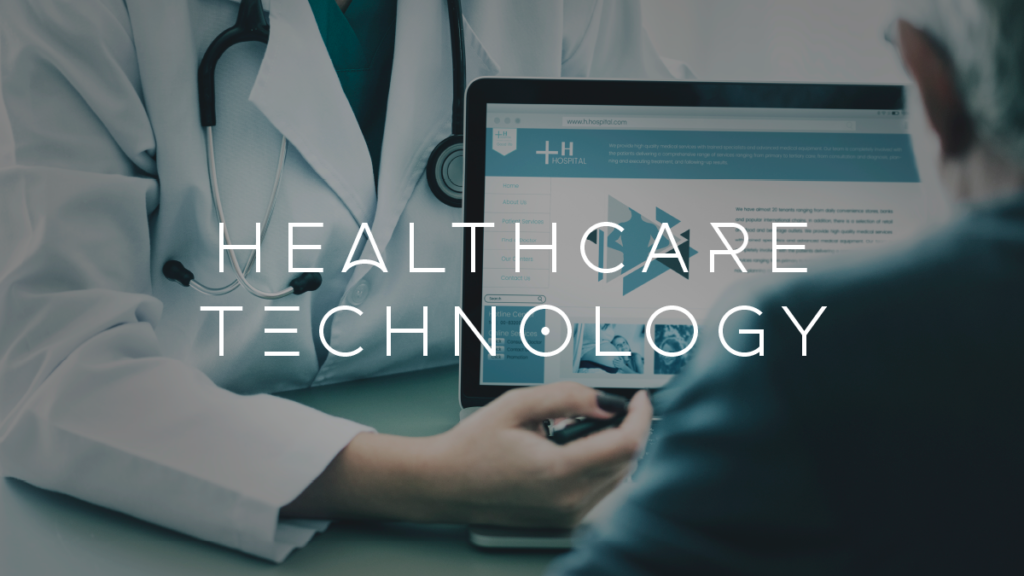Innovations That Shaped Modern Britain: A Reflection Ahead of King Charles’ Coronation

As we prepare for the coronation of King Charles III it is worth reflecting on the many innovations that have arrived in the last 75 years that we now could not live without.
Over the span of a single lifetime, technology has shaped the world and the way we live. Technology lies at the heart of how we as individuals navigate this changing world. From modern electronics to computers, smartphones, the internet, brain imaging and more, everyday life in 2023 is vastly different from what it was back when Charles and Camilla were first born. These inventions have revolutionised the way we live, work, and interact with each other. As we look to the future, it’s clear that innovation will continue to shape our world, and we can’t wait to see what new inventions will emerge under the reign of King Charles.
Let’s start with 1953, the year of Queen Elisabeth’s coronation. Many innovations have come and gone, but these are some of the key ones that we believe have played a sustaining and pivotal role in shaping our lives and continue to do so.

DNA -1953
The discovery of DNA, by Englishman Francis Crick and American James Watson at Cambridge University, marked a milestone in the history of science and gave rise to modern molecular biology and an understanding of how cells work. In short order, their discovery yielded ground-breaking insights into genetics, paving the way for gene sequencing and unlocking the secrets of the human genome, leading to breakthroughs in medicine and personalised treatments that we have today.
Personal Computer – 1957
The year in which the first satellite is launched, Sputnik 1, is also the year when the first personal computer used by one person and controlled by a keyboard, the IBM 610, is invented by IBM. Designed to be used in an office. However, Its price was $55,000, or it could be rented for $1150 per month or $460 for academics). Not surprising that only 180 units were made.
The first personal computer, the Altair 8800, was introduced in 1975, the same year that Apple was founded. It mainly appealed to hobbyists. The personal computer industry truly began in 1977, with the introduction of three preassembled mass-produced personal computers. Since then, PCs have developed further and become an essential part of everyday life. It is not understated to say they have revolutionised the way we work, communicate, and entertain ourselves.
Touch Tone Phone – 1963
This year saw the introduction of the Touch Tone telephone – push button technology to dial a number rather than the rotary dial. People who have only ever used a smart phone will not appreciate this telecoms revolution, except suffice to say, that all smart phones use touch tone technology. A whole new world of customer service was opened using this phone technology. Companies found ways to help callers to reach the right contact or obtain account information by simply pressing keys on their phone keypad.
ATM – 1967
In 1967, the first automated teller machine (ATM) was introduced in the UK. The invention allowed customers to withdraw cash and perform basic banking transactions without the need for a teller. Today, ATMs are ubiquitous around the world, and have revolutionised the way we access and manage our finances.
Are ATMs under threat from online and mobile banking? While physical cash still plays a role – probably not. In fact, many banks are investing in new technologies to improve the functionality of ATMs, such as offering video conferencing with tellers or allowing customers to make deposits and withdrawals using their smartphones. So, while the role of ATMs may evolve in the coming years, it seems unlikely that they will disappear entirely any time soon.
Magnetic Resonance Imaging (MRI) – 1978
The ground-breaking discovery of magnetic resonance imaging (MRI) by Sir Peter Mansfield and his colleagues at the University of Nottingham has had a profound impact on modern healthcare. This invention has revolutionised medical diagnosis and treatment, allowing doctors to visualise internal organs and tissues without invasive procedures. We now rely heavily on MRI for the accurate diagnosis of a wide range of conditions, including cancer, stroke, and brain disorders. MRI technology has been a lifesaver for a lot of people and without it, our medical field would not have seen the many advancements and breakthroughs it has today.
Mobile Phone – 1973
Imagine the world without mobiles. You have to be a certain age to successfully do so and yes Charles and Camilla qualify. Even though phones had been around since the 1940s, it wasn’t until 1973 that Martin Cooper developed the first handheld cellular phones as we know them, but it wasn’t till the 1990’s before they became more accessible and affordable or everyone. The first commercially available cell phone was produced by Motorola and launched in 1984.
Today with high-speed internet connectivity, touchscreen displays, and advanced cameras, smartphones have become a ubiquitous tool for communication, entertainment, and productivity. From managing our schedules to staying connected with loved ones across the globe, smartphones (the new name for mobiles) have changed the way we live and have made our lives more convenient and efficientreparing for the new CQC framework can be challenging, especially when there are so many other day-to-day responsibilities to attend to. However, it’s important to remember that these changes are significant and require providers to take action in order to maintain compliance and deliver quality adult social care. Seeking external support from an interim expert can be a wise investment in ensuring readiness for the new regime. Remember, being proactive now can save time and effort in the long run.
Barcode – 1974
Barcodes have evolved from just tags for products to m so much more today. Invented in the 1970s by George Laurer, bar codes have revolutionised the retail industry and has become an essential tool for tracking inventory and improving efficiency in many industries. They are used for fast and accurate identification of products, making the checkout process smoother and faster for both customers and retailers. Today, bar code technology is used in a wide range of applications, from tracking packages to managing supply chains, and has become an indispensable part of modern commerce
Digital Camera – 1975
Steven Sassoon, a 24-year-old Eastman Kodak engineer from Brooklyn invented the digital camera, thus sparking a revolution of how we take and view pictures. The next years saw continuous development and adoption of the technology with the market for cameral film being obliterated nearly overnight, and Kodak’s fortunes almost with it.
Today, you can find digital cameras in several devices such as mobile phones and laptops capable of taking near-perfect pictures. Will these smartphones replace the digital camera – not while you still need professional photography, where image quality and resolution is still superior.
Global Positioning System (GPS) – 1978
GPS stands for Global Positioning System and we’d be lost without it (quite literally).
Have you ever used a smartphone app to find directions to some new meeting place or to avoid traffic on your commute? Have you ever used one to get a taxi quickly? What about to log your miles on a quick run? Today’s self-driving cars depend on it to function. What we take for granted is powered by a technology leap called the Global Positioning System (GPS).
While the technology had been under development since the WW2, the first service called Navstar GPS, was launched in 1978. This space-based technology is owned by the U.S. government and restricted to military use. It wasn’t until 2000 that non-military persons were given access to GPS signals. Since then, the technology and accuracy has rapidly developed and will continue to shape our world and lives.
The Internet (World Wide Web) – 1983
Of all the technologies that changed our lives, perhaps the most profound of the last 50 years has been the web. While the internet can trace its origin back to 1969, with early computer information exchange for research, its official birthday is considered to be 1 January, 1983. Prior to this, the various computer networks did not have a standard way to communicate with each other. This changed with the arrival of Transfer Control Protocol/Internetwork Protocol (TCP/IP). This allowed different kinds of computers on different networks to “talk” to each other. From this day all networks could now be connected by a universal language.
The Web opened to the public in 1991 and began to enter general use in 1993-4, when websites for everyday use started to become available. But it wasn’t the ability for computers to talk to each other and for documents to be able to be hyperlinked that made the most impact. Instead, it was the application that presented all that information to users, the browser. It allowed untrained users to click and browse from website to website.
Today, we all recognise that the arrival of the internet has changed the course of human history.
Google – 1996
With the rise of the internet and browsers, two students came up with the idea of what will now be known as a search engine. Larry Page and Sergey Brin revealed the first version of a web crawler that examined all the 10 million documents on the world wide web at that time in 1996. Internet Technology has rapidly developed since then with online shopping and games that give us access to things like online slots. Today, Google is a powerhouse that has developed vastly since its initial version and even has many other ventures in the tech world like YouTube, Android, and so on. You cannot talk about the evolution of the internet without mentioning Google.
Bluetooth – 1999
The arrival of Bluetooth technology in 1999 was a game changer for the world of wireless technology. Despite the challenges that came with the first version, it was a great start. Over the next decade, more development and improvements were made, eventually leading to the ubiquitous presence of Bluetooth in almost every gadget today. Bluetooth has been a key player in the smartphone revolution, enabling wireless earbuds and smartwatches to become commonplace. It’s amazing to think that what started as a simple wireless communication protocol has now become an essential component of modern technology.
Big Data – 2005
People have been using data to analyse things since the beginning of time. But in the early 2000s, the Internet and the Web began to offer unique data collections and data analysis opportunities. With the expansion of web traffic and ecommerce, companies such as Amazon started to analyse customer behaviour by looking at click-rates, IP-specific location data and search logs. This opened a whole new world of possibilities.
Although it is not exactly known who first used the term, most people credit John R. Mashey (who at the time worked at Silicon Graphics) for making the term big data popular. The rise of big data analytics has revolutionised the way we understand and interpret vast amounts of information. By leveraging machine learning algorithms and powerful computing resources, businesses and governments can gain insights from data in ways that were once impossible. From predicting consumer behaviour to detecting fraud, big data analytics has opened up new opportunities for innovation. By analysing data in real-time, organisations can make more informed decisions, improve efficiency, and gain a competitive edge. However, as with any technology, there are also concerns about data privacy and the potential for misuse.
Smartphones – 2007
Smartphones have become an indispensable part of modern life giving us access to the rich world of the internet and mobile apps that enable us to perform a variety of functions on a single small device. It sits in our hands to the point of addiction for many of us.
The first smartphone, the IBM Simon, was introduced in 1993, but it wasn’t until the release of the iPhone in 2007 that smartphones became widely popular. Today, smartphones have evolved to offer high-speed internet access, email, GPS navigation, and a world of apps.
When established experts predict that 5G networks, with faster speeds and increased bandwidth, will make life-changing technologies like real-time telemedicine, virual reality training and smart cities a reality.
From staying connected with friends and family to accessing important information on the go, smartphones have become an essential tool for navigating the modern world.
Conclusion
No doubt there will be some glaring omissions, and readers will probably think of others. Today, we are on the cusp of seeing new technologies being developed such as driverless vehicles, artificial intelligence, and those fuelling the renewable energy industry. Like those featured they will become more prevalent and impactful on society. These new developments have been made possible by the progress that we have made in recent decades. While lives and ways of living have been transformed, not everyone has access to them. Elderly people or those people and nations on the planet without the resources to afford the latest technology may feel cut off from the evolutionary flow of things. Should this concern us?
As King Charles begins his reign, and with his interest in climate change and sustainability, it’s clear that the innovations of the future should be geared towards creating a better and more equitable future for our planet.


